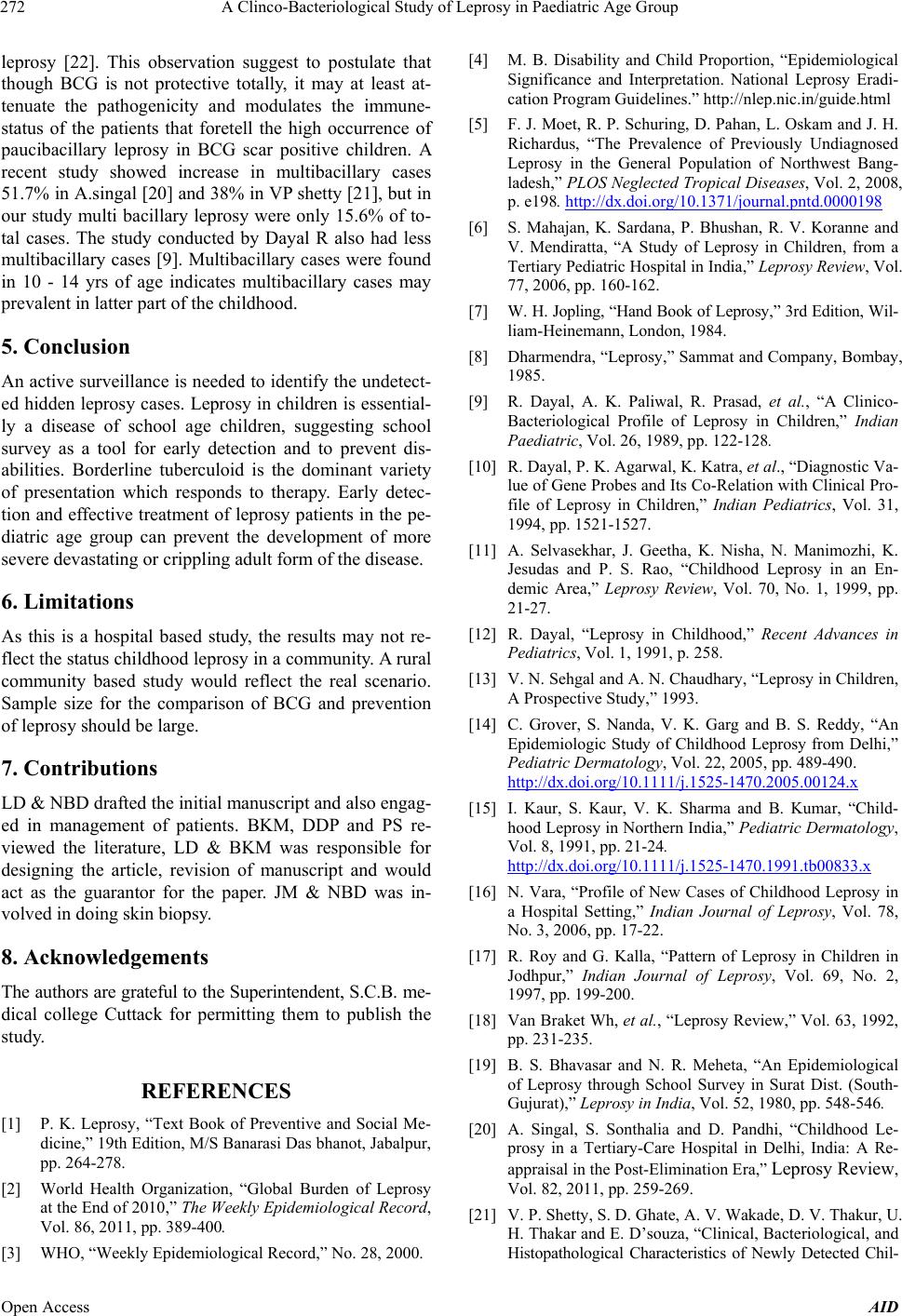
A Clinco-Bacteriological Study of Leprosy in Paediatric Age Group
272
leprosy [22]. This observation suggest to postulate that
though BCG is not protective totally, it may at least at-
tenuate the pathogenicity and modulates the immune-
status of the patients that foretell the high occurrence of
paucibacillary leprosy in BCG scar positive children. A
recent study showed increase in multibacillary cases
51.7% in A.singal [20] and 38% in VP shetty [21], but in
our study multi bacillary leprosy were only 15.6% of to-
tal cases. The study conducted by Dayal R also had less
multibacillary cases [9]. Multibacillary cases were found
in 10 - 14 yrs of age indicates multibacillary cases may
prevalent in latter part of the childhood.
5. Conclusion
An active surveillance is needed to identify the undetect-
ed hidden leprosy cases. Leprosy in children is essential-
ly a disease of school age children, suggesting school
survey as a tool for early detection and to prevent dis-
abilities. Borderline tuberculoid is the dominant variety
of presentation which responds to therapy. Early detec-
tion and effective treatment of leprosy patients in the pe-
diatric age group can prevent the development of more
severe devastating or crippling adult form of the disease.
6. Limitations
As this is a hospital based study, the results may not re-
flect the status childhood leprosy in a community. A rural
community based study would reflect the real scenario.
Sample size for the comparison of BCG and prevention
of leprosy should be large.
7. Contributions
LD & NBD drafted the initial manuscript and also engag-
ed in management of patients. BKM, DDP and PS re-
viewed the literature, LD & BKM was responsible for
designing the article, revision of manuscript and would
act as the guarantor for the paper. JM & NBD was in-
volved in doing skin biopsy.
8. Acknowledgements
The authors are grateful to the Superintendent, S.C.B. me-
dical college Cuttack for permitting them to publish the
study.
REFERENCES
[1] P. K. Leprosy, “Text Book of Preventive and Social Me-
dicine,” 19th Edition, M/S Banarasi Das bhanot, Jabalpur,
pp. 264-278.
[2] World Health Organization, “Global Burden of Leprosy
at the End of 2010,” The Weekly Epidemiological Record,
Vol. 86, 2011, pp. 389-400.
[3] WHO, “Weekly Epidemiological Record,” No. 28, 2000.
[4] M. B. Disability and Child Proportion, “Epidemiological
Significance and Interpretation. National Leprosy Eradi-
cation Program Guidelines.” http://nlep.nic.in/guide.html
[5] F. J. Moet, R. P. Schuring, D. Pahan, L. Oskam and J. H.
Richardus, “The Prevalence of Previously Undiagnosed
Leprosy in the General Population of Northwest Bang-
ladesh,” PLOS Neglected Tropical Diseases, Vol. 2, 2008,
p. e198. http://dx.doi.org/10.1371/journal.pntd.0000198
[6] S. Mahajan, K. Sardana, P. Bhushan, R. V. Koranne and
V. Mendiratta, “A Study of Leprosy in Children, from a
Tertiary Pediatric Hospital in India,” Leprosy Review, Vol.
77, 2006, pp. 160-162.
[7] W. H. Jopling, “Hand Book of Leprosy,” 3rd Edition, Wil-
liam-Heinemann, London, 1984.
[8] Dharmendra, “Leprosy,” Sammat and Company, Bombay,
1985.
[9] R. Dayal, A. K. Paliwal, R. Prasad, et al., “A Clinico-
Bacteriological Profile of Leprosy in Children,” Indian
Paediatric, Vol. 26, 1989, pp. 122-128.
[10] R. Dayal, P. K. Agarwal, K. Katra, et al., “Diagnostic Va-
lue of Gene Probes and Its Co-Relation with Clinical Pro-
file of Leprosy in Children,” Indian Pediatrics, Vol. 31,
1994, pp. 1521-1527.
[11] A. Selvasekhar, J. Geetha, K. Nisha, N. Manimozhi, K.
Jesudas and P. S. Rao, “Childhood Leprosy in an En-
demic Area,” Leprosy Review, Vol. 70, No. 1, 1999, pp.
21-27.
[12] R. Dayal, “Leprosy in Childhood,” Recent Advances in
Pediatrics, Vol. 1, 1991, p. 258.
[13] V. N. Sehgal and A. N. Chaudhary, “Leprosy in Children,
A Prospective Study,” 1993.
[14] C. Grover, S. Nanda, V. K. Garg and B. S. Reddy, “An
Epidemiologic Study of Childhood Leprosy from Delhi,”
Pediatric Dermatology, Vol. 22, 2005, pp. 489-490.
http://dx.doi.org/10.1111/j.1525-1470.2005.00124.x
[15] I. Kaur, S. Kaur, V. K. Sharma and B. Kumar, “Child-
hood Leprosy in Northern India,” Pediatric Dermatology,
Vol. 8, 1991, pp. 21-24.
http://dx.doi.org/10.1111/j.1525-1470.1991.tb00833.x
[16] N. Vara, “Profile of New Cases of Childhood Leprosy in
a Hospital Setting,” Indian Journal of Leprosy, Vol. 78,
No. 3, 2006, pp. 17-22.
[17] R. Roy and G. Kalla, “Pattern of Leprosy in Children in
Jodhpur,” Indian Journal of Leprosy, Vol. 69, No. 2,
1997, pp. 199-200.
[18] Van Braket Wh, et al., “Leprosy Review,” Vol. 63, 1992,
pp. 231-235.
[19] B. S. Bhavasar and N. R. Meheta, “An Epidemiological
of Leprosy through School Survey in Surat Dist. (South-
Gujurat),” Leprosy in India, Vol. 52, 1980, pp. 548-546.
[20] A. Singal, S. Sonthalia and D. Pandhi, “Childhood Le-
prosy in a Tertiary-Care Hospital in Delhi, India: A Re-
appraisal in the Post-Elimination Era,” Leprosy Review,
Vol. 82, 2011, pp. 259-269.
[21] V. P. Shetty, S. D. Ghate, A. V. Wakade, D. V. Thakur, U.
H. Thakar and E. D’souza, “Clinical, Bacteriological, and
Histopathological Characteristics of Newly Detected Chil-
Open Access AID